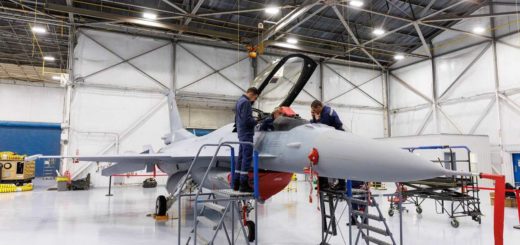Bulgaria’s Air Force Modernization Gains Momentum with Latest F-16 Block 70 Delivery
{loadposition bannertop}
{loadposition sidebarpub}
Two more F-16 Block 70 fighter jets landed at Graf Ignatievo Air Base on October 18, marking Bulgaria’s latest step in modernizing its air fleet. The delivery strengthens Bulgaria’s NATO interoperability and replaces outdated MiG-29s, enhancing defense readiness along the Alliance’s eastern flank.
On Saturday, 18 October 2025, two additional F-16 Block 70 fighter jets landed at the Third Air Base in Graf Ignatievo, marking a new milestone in Bulgaria’s long-planned fleet recapitalization, as reported by the Ministry of Defence of Bulgaria and the Bulgarian news agency (BTA). The delivery follows the 2019 government-to-government agreement with the United States and continues a steady intake that began earlier this year. The move matters for national air sovereignty and NATO mission readiness, replacing aging Soviet-era assets and consolidating Bulgaria’s role on the Alliance’s eastern flank. The aircraft were received in the presence of Defence Minister Atanas Zapryanov and senior Air Force leadership, with the ministry confirming that the final pair under the first batch is due by year-end.
Follow Army Recognition on Google News at this link
Two Bulgarian F-16 Block 70 fighter jets stand on the runway at Graf Ignatievo Air Base, freshly delivered under the 2019 U.S. defense contract. Their arrival marks a key step in Bulgaria’s air force modernization (Bulgarian MoD)
The arrival completes six of the eight aircraft contracted in 2019, following earlier deliveries on April 2 and June 8, and two jets on October 3. Authorities reiterated that technological acceptance, test flights, and the progressive stand-up of training infrastructure, including a fast-tracked simulator facility, are underway at Graf Ignatievo. These steps are designed to accelerate pilot conversion and enable the assumption of combat duty once contractual conditions are met.
At the heart of the program is the F-16 Block 70, the most advanced “Viper” production standard. It integrates the AN/APG-83 SABR AESA radar for high-fidelity target detection and multi-track engagement, a modern modular mission computer, Link-16 tactical datalink, and compatibility with advanced weapons and targeting pods such as Sniper. Compared with legacy mechanically scanned APG-68 radars on earlier F-16 blocks, Block 70’s sensor suite dramatically improves situational awareness, electronic protection, and beyond-visual-range performance while pairing with an extended 12,000-hour service life airframe and optional conformal fuel tanks for endurance. These upgrades position Bulgaria’s fleet on par with the latest regional F-16 users and above the capabilities of its retired MiG-29s in networked operations, reliability, and multi-role flexibility.
Operationally, the F-16’s history stretches back to the late 1970s as a lightweight fighter that evolved into a true multi-role platform adopted by more than two dozen air forces. Successive blocks introduced stronger engines, precision-strike avionics, and advanced EW suites; the 1990s Block 50/52 standard broadened the weapons envelope and improved radar and mission systems, paving the way for today’s Viper configuration. The Block 70/72 iteration builds on that lineage with contemporary sensors, computing, and structural life, creating a bridge between fourth-generation agility and fifth-generation networking concepts that NATO increasingly emphasizes.
For Bulgaria and NATO, the strategic implications are tangible. On the geostrategic plane, the new jets enhance the Alliance’s air policing resilience over the Black Sea region, deter incursions, and improve the credibility of contingency plans along the eastern and southeastern flanks. Militarily, AESA-equipped F-16s expand the Bulgarian Air Force’s ability to share a common air picture, coordinate with Allied command and control via Link-16, and employ modern air-to-air missiles like AIM-120C7 as part of integrated air and missile defense schemes. The capability uplift reduces reliance on allied backfilling for QRA tasks and deepens interoperability during multinational exercises and real-world responses shaped by the war in Ukraine and evolving Russian military activity.
Program finances and contracting reflect a multi-stage acquisition. Bulgaria’s initial 2019 package for eight F-16 Block 70 aircraft and associated training and equipment has been publicly valued at around $1.3 billion, with U.S. notifications indicating an upper estimate of $1.673 billion depending on options and support lines. A follow-on decision in 2022 authorized a second batch of eight aircraft, widely cited at roughly $1.3 billion, bringing the planned fleet to a full squadron of 16 by the latter part of the decade. On the industrial side, Lockheed Martin Aeronautics received a U.S. Department of Defense production award in April 2020, valued at about $512 million, for Bulgaria’s Block 70 jets, with work in Fort Worth and Greenville supporting deliveries.
Today’s delivery cadence confirms that the program is back on a predictable trajectory after earlier global supply-chain delays, with Bulgarian officials stressing parallel progress on infrastructure and simulator training to convert local crews. According to the Air Force, six pilots are cleared on type, with additional sorties required to qualify the full cadre on Bulgaria’s specific configuration before declaring combat duty. With six aircraft now on home soil and two more expected by the end of 2025 to close the first contract, Sofia is moving toward fielding a modern, networked air arm capable of fulfilling national air policing and allied taskings with greater autonomy.
Bulgaria’s latest Viper arrivals are therefore more than a simple fleet increment; they are a decisive step in shifting from legacy platforms to a NATO-standard, sensor-rich fighter force that can deter, integrate, and, if required, fight effectively in a contested regional airspace. The continued deliveries, training maturation, and infrastructure build-out signal that the country is converting investment into credible combat power at the pace required by its security environment.
Written by Teoman S. Nicanci – Defense Analyst, Army Recognition Group
Teoman S. Nicanci holds degrees in Political Science, Comparative and International Politics, and International Relations and Diplomacy from leading Belgian universities, with research focused on Russian strategic behavior, defense technology, and modern warfare. He is a defense analyst at Army Recognition, specializing in the global defense industry, military armament, and emerging defense technologies.

{loadposition bannertop}
{loadposition sidebarpub}
Two more F-16 Block 70 fighter jets landed at Graf Ignatievo Air Base on October 18, marking Bulgaria’s latest step in modernizing its air fleet. The delivery strengthens Bulgaria’s NATO interoperability and replaces outdated MiG-29s, enhancing defense readiness along the Alliance’s eastern flank.
On Saturday, 18 October 2025, two additional F-16 Block 70 fighter jets landed at the Third Air Base in Graf Ignatievo, marking a new milestone in Bulgaria’s long-planned fleet recapitalization, as reported by the Ministry of Defence of Bulgaria and the Bulgarian news agency (BTA). The delivery follows the 2019 government-to-government agreement with the United States and continues a steady intake that began earlier this year. The move matters for national air sovereignty and NATO mission readiness, replacing aging Soviet-era assets and consolidating Bulgaria’s role on the Alliance’s eastern flank. The aircraft were received in the presence of Defence Minister Atanas Zapryanov and senior Air Force leadership, with the ministry confirming that the final pair under the first batch is due by year-end.
Two Bulgarian F-16 Block 70 fighter jets stand on the runway at Graf Ignatievo Air Base, freshly delivered under the 2019 U.S. defense contract. Their arrival marks a key step in Bulgaria’s air force modernization (Bulgarian MoD)
The arrival completes six of the eight aircraft contracted in 2019, following earlier deliveries on April 2 and June 8, and two jets on October 3. Authorities reiterated that technological acceptance, test flights, and the progressive stand-up of training infrastructure, including a fast-tracked simulator facility, are underway at Graf Ignatievo. These steps are designed to accelerate pilot conversion and enable the assumption of combat duty once contractual conditions are met.
At the heart of the program is the F-16 Block 70, the most advanced “Viper” production standard. It integrates the AN/APG-83 SABR AESA radar for high-fidelity target detection and multi-track engagement, a modern modular mission computer, Link-16 tactical datalink, and compatibility with advanced weapons and targeting pods such as Sniper. Compared with legacy mechanically scanned APG-68 radars on earlier F-16 blocks, Block 70’s sensor suite dramatically improves situational awareness, electronic protection, and beyond-visual-range performance while pairing with an extended 12,000-hour service life airframe and optional conformal fuel tanks for endurance. These upgrades position Bulgaria’s fleet on par with the latest regional F-16 users and above the capabilities of its retired MiG-29s in networked operations, reliability, and multi-role flexibility.
Operationally, the F-16’s history stretches back to the late 1970s as a lightweight fighter that evolved into a true multi-role platform adopted by more than two dozen air forces. Successive blocks introduced stronger engines, precision-strike avionics, and advanced EW suites; the 1990s Block 50/52 standard broadened the weapons envelope and improved radar and mission systems, paving the way for today’s Viper configuration. The Block 70/72 iteration builds on that lineage with contemporary sensors, computing, and structural life, creating a bridge between fourth-generation agility and fifth-generation networking concepts that NATO increasingly emphasizes.
For Bulgaria and NATO, the strategic implications are tangible. On the geostrategic plane, the new jets enhance the Alliance’s air policing resilience over the Black Sea region, deter incursions, and improve the credibility of contingency plans along the eastern and southeastern flanks. Militarily, AESA-equipped F-16s expand the Bulgarian Air Force’s ability to share a common air picture, coordinate with Allied command and control via Link-16, and employ modern air-to-air missiles like AIM-120C7 as part of integrated air and missile defense schemes. The capability uplift reduces reliance on allied backfilling for QRA tasks and deepens interoperability during multinational exercises and real-world responses shaped by the war in Ukraine and evolving Russian military activity.
Program finances and contracting reflect a multi-stage acquisition. Bulgaria’s initial 2019 package for eight F-16 Block 70 aircraft and associated training and equipment has been publicly valued at around $1.3 billion, with U.S. notifications indicating an upper estimate of $1.673 billion depending on options and support lines. A follow-on decision in 2022 authorized a second batch of eight aircraft, widely cited at roughly $1.3 billion, bringing the planned fleet to a full squadron of 16 by the latter part of the decade. On the industrial side, Lockheed Martin Aeronautics received a U.S. Department of Defense production award in April 2020, valued at about $512 million, for Bulgaria’s Block 70 jets, with work in Fort Worth and Greenville supporting deliveries.
Today’s delivery cadence confirms that the program is back on a predictable trajectory after earlier global supply-chain delays, with Bulgarian officials stressing parallel progress on infrastructure and simulator training to convert local crews. According to the Air Force, six pilots are cleared on type, with additional sorties required to qualify the full cadre on Bulgaria’s specific configuration before declaring combat duty. With six aircraft now on home soil and two more expected by the end of 2025 to close the first contract, Sofia is moving toward fielding a modern, networked air arm capable of fulfilling national air policing and allied taskings with greater autonomy.
Bulgaria’s latest Viper arrivals are therefore more than a simple fleet increment; they are a decisive step in shifting from legacy platforms to a NATO-standard, sensor-rich fighter force that can deter, integrate, and, if required, fight effectively in a contested regional airspace. The continued deliveries, training maturation, and infrastructure build-out signal that the country is converting investment into credible combat power at the pace required by its security environment.
Written by Teoman S. Nicanci – Defense Analyst, Army Recognition Group
Teoman S. Nicanci holds degrees in Political Science, Comparative and International Politics, and International Relations and Diplomacy from leading Belgian universities, with research focused on Russian strategic behavior, defense technology, and modern warfare. He is a defense analyst at Army Recognition, specializing in the global defense industry, military armament, and emerging defense technologies.








